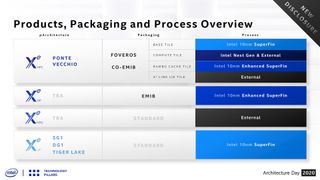Intel promises enthusiast gaming GPU to take on AMD and Nvidia in 2021. It's a ray tracing three-way
So Intel is working on a high-end gaming graphics card after all, and one with ray tracing acceleration at that.

Intel is preparing an Intel Xe graphics architecture for gaming. Known as Xe-HPG, and announced by Raja Koduri during today's Architecture Day, the new microarchitecture variant of Intel's discrete graphics will sit as an amalgam of low-power and big data chips and feature real-time ray tracing acceleration.
After a year of contrary information on whether Intel would be building a gaming chip out of its upcoming GPU architecture, it has now confirmed that it will with Xe-HPG. We don't know a great deal about the architecture just yet, only how it relates to the known configurations of Intel Xe.
The Intel Xe microarchitectures are as follows:
- Xe-LP - Low-power GPU with up to 96 EUs. Launching within Intel Tiger Lake.
- Xe-HP - Intended for datacentre use, and scalable from single to four tile configurations. Launching 2021.
- Xe-HPG - The new gaming architecture. Expected to be scalable to beyond a single tile and will feature support for GDDR6. Launching 2021.
- Xe-HPC - Intended for use within supercomputers, such as the Aurora supercomputer planned for 2021.
What we know so far of Xe-HPG is that it will blend the "good performance/watt" from Xe-LP, the "scale from Xe-HP for a bigger configuration", and the "compute frequency optimisation" from the datacentre-grade Xe-HPC microarchitecture. One would assume that means the possibility of a multi-tiled GPU that strings together more and one single Intel Xe GPU tile.
Intel has confirmed that the Xe-HP architecture will use this tiled approach to function as a "multicore GPU", and so we suspect the same may be said for some configurations of the Xe-HPG architecture.
"At Architecture Day, Intel demonstrated Xe-HP transcoding 10 full streams of high quality 4K video at 60 FPS on a single tile," the company's press release reads. But how that will translate to gaming performance we cannot say for sure just yet. There are a great deal of factors that need to be taken into consideration before we can make any accurate guesses as to shipping performance.

At least we know Intel has an eye to keep down costs. While datacentre GPUs can set you back a pretty penny, gaming GPUs are far more competitively priced. Intel will be shipping Xe-HPG with GDDR6 memory to ensure costs are kept to a minimum.
The biggest gaming news, reviews and hardware deals
Keep up to date with the most important stories and the best deals, as picked by the PC Gamer team.
What's perhaps most surprising is that Intel feels fit to integrate real-time ray tracing acceleration with its first foray into the discrete gaming GPU world. So far only Nvidia's RTX 20-series GPUs support acceleration in silicon, however, we're expecting it to improve on ray-traced performance with the next-gen Nvidia Ampere graphics cards, which we'll hear more about on September 1.
Similarly, AMD has confirmed support with its RDNA 2 architecture, which is on track to launch before the year's up.

Best CPU for gaming: the top chips from Intel and AMD
Best graphics card: your perfect pixel-pusher awaits
Best SSD for gaming: get into the game ahead of the rest
With Intel's announcement of a purpose-built gaming GPU, 2021 will see a three-way battle for a spot in our gaming PCs.
And it appears all three will be built on TSMC's processes. Intel has confirmed that Intel Xe-HPG will be built using an external foundry, and all signs point towards TSMC. That's the same place AMD and Nvidia currently use for their chips, although Nvidia has also been rumoured to use Samsung for some capacity.
Prior to that, we'll first see Intel Xe within Intel Tiger Lake processors. These will be launched on September 2, 2020, and will come with up to 96 EUs and the brand new 10nm SuperFin technology at the heart of Willow Cove.
There's a lot to come from Intel in these coming months, and I have to say it's exciting to see it pushing a heap of new product onto the scene.

Jacob earned his first byline writing for his own tech blog. From there, he graduated to professionally breaking things as hardware writer at PCGamesN, and would go on to run the team as hardware editor. He joined PC Gamer's top staff as senior hardware editor before becoming managing editor of the hardware team, and you'll now find him reporting on the latest developments in the technology and gaming industries and testing the newest PC components.
Most Popular






